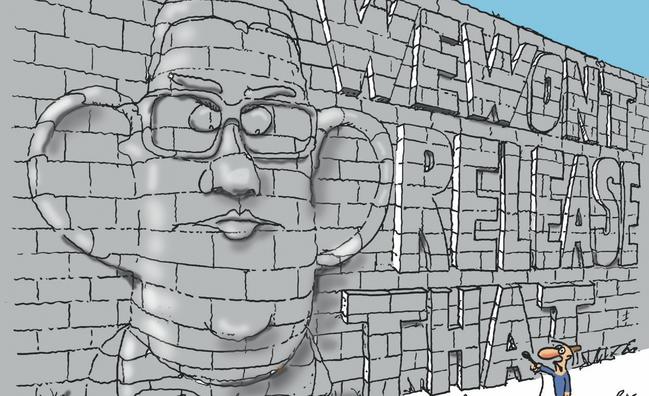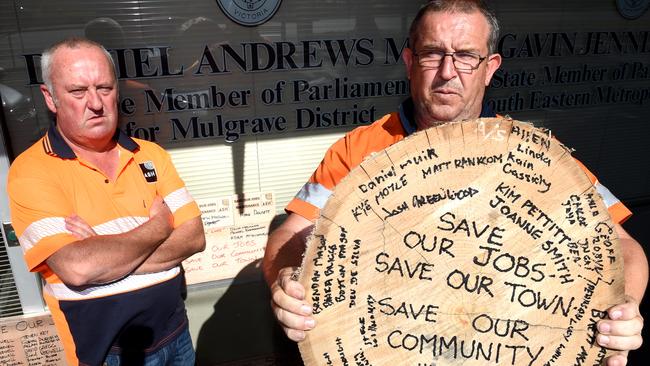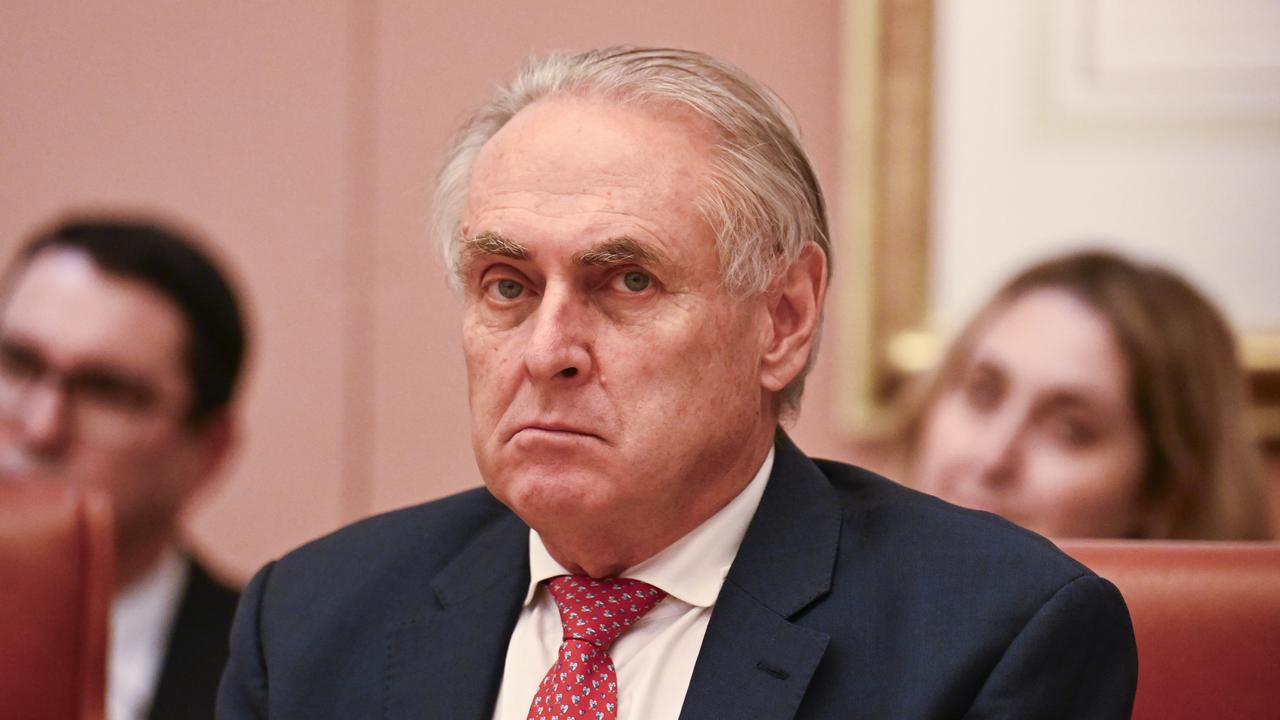Premier Daniel Andrews stonewalls release of documents
Farmers, forest contractors and rural councils have hit brick walls trying to access crucial government documents. See our timelines of requests and rejections.

Regional Victorians say they have had enough of Premier Daniel Andrews’ obsession with “absolute control” and repeated refusal to subject his government to public scrutiny.
A Weekly Times investigation can reveal farmers, forest contractors, rural councils and even bushfire scientists are hitting brick walls in their attempts to gain access to key government data and documents.
This includes Mr Andrews’ refusal to release documents underpinning his ruling that native-forest logging is “not sustainable” and must be phased out by 2030 with the loss of 2500 jobs.
Wellington Shire mayor Garry Stephens, who chairs the Native Timber Taskforce, said “we have gone back and forth so many times, following correct processes, requesting the scientific data we were told underpins the Government’s decision, but we have been stonewalled at every juncture”.

Neerim South harvest and haulage logging contractor Chris Stafford, who employs five locals, said “we feel like we’re just banging our heads up against the wall”.
“I can’t believe they’re not held accountable for their decisions and don’t have evidence to back it up,” Mr Stafford said. “Is it even legal that the Government won’t give us information on why they’re doing this?”
Simple requests for documents to be released have been met with refusals, forcing the media and some regional communities to lodge Freedom of Information applications that the government has dismissed.
Grain growers have been left stranded with a $440 million half-built Murray Basin Rail freight network, on the basis it’s not worth completing according to a revised business case that Transport Infrastructure Minister Jacinta Allan refuses to fully release.
Industry leaders say failure to complete the $440 million rail project has reduced the efficiency of the rail freight network and put more trucks on rural roads and city streets.
Victorian Farmers Federation grains group president Ashley Fraser the Government’s refusal to release the revised Murray Basin Rail business case showed “we’re second-class citizens, who aren’t given the time of day”.
Scientists and communities at risk of catastrophic bushfires have also been stunned at the Government’s refusal to release maps showing forest fuel loads.
The maps would show the build-up of fuels in the wake of the Government’s decision to abandon the 2009 Victorian Bushfires Royal Commission’s recommendation conduct planned burns across 5 per cent of the state’s public land annually, equal to 385,000ha.
University of Melbourne Associate Professor of fire ecology Kevin Tolhurst said it appeared the Government wanted to “maintain absolute control” over its fire maps.
Professor Tolhurst said the Department of Environment, Land, Water and Planning was not even allowing consultants access to its fuel layer maps and fire history layers, as “they don’t want someone else to cross check their work”.
The timely release of controversial departmental and agency reports have also been repeatedly delayed.
In the lead-up to the 2018 State Election, when Victoria’s fire services were being carved up, the annual reports for the CFA and MFB were delayed until after the November election, despite being normally tabled with parliament in September.
Meanwhile, the Premier has twice suspended parliament, delaying further scrutiny of his Government’s performance. That’s despite Labor’s 2014 platform election document stating: “the right to govern is a privilege and it must never be taken for granted. Governments must also be honest and transparent. Respect for the Victorian people starts with respect for our democracy”.
The Premier’s spokeswoman said “all decisions about FOI requests are made by departments, not by Ministers, in accordance with the Act
“Consulting with the community and being as transparent as possible about government decisions is always a priority – to suggest otherwise is simply wrong.”
But Victorian Opposition Nationals Leader Peter Walsh said departments were “no longer independent of government and are totally politicised by the Labor Party, which has positioned former staff and party members into positions of influence within them”.
TIMELINES:
ROADBLOCKS ON ACCESS TO FUEL-LOAD MAPS
HOW MURRAY BASIN RAIL PROJECT WAS DERAILED
HOW TIMBER COMMUNITIES WERE STONEWALLED
FIRE ROADBLOCK ON FUEL-LOAD MAPS
Premier Daniel Andrews, his ministers and bureaucrats have refused repeated calls to release maps showing the dangerous build-up of forest fuel loads across Victoria and abandoned the Black Saturday Royal Commission’s calls to conduct planned burns on at least 5 per cent of public land annually, equal to 385,000ha.
AUGUST 2018: The Weekly Times asks the Department of Environment, Land, Water and Planning for forest fuel-load data in tonnes per hectare, given the Government had cut planned burns.
SEPTEMBER 3, 2018: DELWP responds by stating: “fuel load data is only published to Business Level Data (and internal system) which means it is only available to internal DELWP users”.
SEPTEMBER 16, 2019: Dry conditions prompt The Weekly Times to lodge a Freedom of Information with DELWP requesting fuel-load maps for the previous five years, which DELWP states will cost $1294.80 to process.
The Weekly Times winds back the request to one fuel- load map covering Victoria’s East Central zone, which covers Kinglake and Healesville, where the February 2009 Black Saturday Kilmore East and Murrindindi fires merged to burn out 169,542ha, killing 119 people and destroying 1242 homes
OCTOBER 24, 2019: DELWP releases the map, which shows the build-up of fuel loads across Black Saturday’s fire zones had reached extreme levels.
NOVEMBER 21, 2019: The Weekly Times asked for the fuel-load maps for East Gippsland and the North East, given fires have sprung up in these areas. But DELWP’s media team states, “we act on the advice of fire experts who have advised that fuel load maps shouldn’t be released at this time”.
NOVEMBER 27, 2019: Parliament’s Upper House passes a motion requiring the Premier to release: “fuel-load maps produced by the Victorian Government in the last three financial years”.
DECEMBER 11, 2019: Then Attorney-General Jill Hennessy says she needs more time and that the Government was “collating and considering the relevant documents”.
FEBRUARY 2020: Premier Daniel Andrews states “we’re not going to provide every arsonist in Victoria with a to-do list”. Bushfire scientists label the Premier’s comments as illogical and argue arsonists don’t do risk assessments before lighting fires and it’s powerlines that have been linked to the state’s most catastrophic bushfires. University of Melbourne bushfire scientist Kevin Tolhurst said the premier’s claim was “ludicrous”, given the summer’s bushfires were started by lightning.
HOW TIMBER COMMUNITIES WERE STONEWALLED
OCTOBER 7, 2019: Then-Agriculture Minister Jaclyn Symes writes to Corryong sawmill owner Graham Walker, reassuring him that his mill and workers had a future, stating: “it is the Victorian Government’s view that the careful management of Victoria’s State Forest can support the sustainable supply of resources as well as protection of biodiversity”.
NOVEMBER 7, 2019: Premier Daniel Andrews announces the timber industry was not sustainable and all native forest logging would end by 2030, stunning the timber industry’s 2500 workers in Corryong, Orbost, Warburton, Noojee, Violet Town, Powelltown, Benalla and Heyfield. From then on Mr Andrews told the media and Parliament native forest logging was “not sustainable into the medium and long term”, but refused to release the science and rationale behind the claim.
NOVEMBER 26, 2019: Wellington and East Gippsland Shires write to the Premier requesting the data and scientific basis for the phase-out decision.
MARCH 26, 2020: Then-Agriculture Minister Jaclyn Symes responds with a letter stating: “While Cabinet decision-making is confidential, I can advise the Government’s decision was informed by wide-ranging consultation and assessment.” No information was supplied on the science behind the decision.
JUNE AND JULY 2020: The Native Timber Taskforce is formed in response to the Government’s refusal to provide the science behind the phase-out. It is chaired by Wellington Shire in partnership with East Gippsland Shire Council, Timber Towns Victoria, National Timber Council, Australia Sustainable Hardwoods, Radial Timber and the Construction Forestry Mining and Energy Union.
JULY 2020: The taskforce lodges Freedom of Information requests seeking all documents relating to the phase-out with the Premier’s office, Agriculture Minister and Department of Jobs, Precincts and Regions.
NOVEMBER 2020: DJPR responds to the s FOI request stating “access is refused to the documents”.
DECEMBER 2020: Mr Andrews’ office responds stating, “the office of the Premier undertook a thorough and diligent search for documents, however no documents relevant to your request were identified”.
APRIL 2021: Wellington and East Gippsland Council release a report estimating their municipalities will lose 1110 jobs once native timber harvesting ends. The taskforce has lodged complaints with the Office of the Victorian Information Commissioner and applications for review by the Victorian Civil and Administrative Tribunal.
JULY 2021: The taskforce receives 159 pages of documents from the Government, most of which are heavily redacted and filled with information that was not requested. The scientific data that was requested in the FOI request was not included.
Taskforce chairman and Wellington Shire mayor Garry Stephens says “what we did finally receive from the Government was rubbish. It was a heavily redacted document that didn’t in any way answer our questions. This has been so difficult that we have no choice but to believe the Government has been deliberately hindering the process in the hope that we will give up and go away.”
FULL MURRAY BASIN RAIL PROJECT BUSINESS CASE DERAILED
AUGUST 2014: The Victorian Government allocates $220 million to the Murray Basin Rail Project, to standardise the Yelta to Maryborough, Sea Lake to Maryborough, and Manangatang to Maryborough lines.
APRIL 2016: The Federal Government matches the state government funding, bringing the total budget to $440m.
JUNE 15, 2018: Management is taken out of V/Line hands and passed to Rail Projects Victoria because of a six-month delay in commissioning the Maryborough to Ararat line, plus growing evidence of faults in the project.
JUNE 2019: Project runs out of steam and funding, with Transport Infrastructure Minister Jacinta Allan forced to wind back the troubled project, abandoning upgrades and standardisation of the Sea Lake and Manangatang lines from broad to narrower standard-gauge track the following month.
AUGUST 2019: Freight trains are forced to crawl along patched tracks at average speeds of 36km/h, with lines closed once the mercury hits 33C during summer.
MARCH 18, 2020: Victorian Auditor-General slams management of project, warning it had “not met scope, time, cost or quality expectations”, was late and would require “a considerable injection of new funds” to achieve its aims.
JUNE 2020: Ms Allan lodges a new business case with the Federal Government, which is kept under wraps, but is rumoured to put the cost of delivering the project in full at $1 billion. But is seeking a much smaller amount for a cut-down project.
OCTOBER 20, 2020: Ms Allan announces the Manangatang and Sea Lake lines would no longer be standardised, allocating just $48.8m to further work, with the Federal Government chipping in $195.2m. She releases a heavily redacted summary of the business case. Rail Freight Alliance chief executive Reid Mather said the business case was funded by taxpayers and should be released. Victorian Farmers Federation grains chairman Ashley Fraser criticises the lack of transparency.


